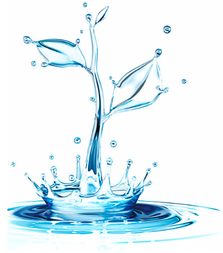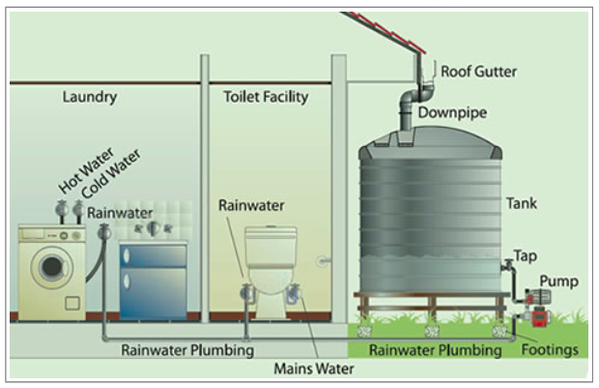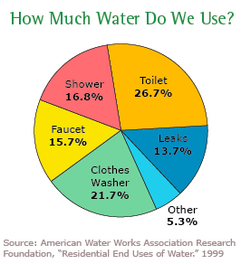Water Usage & Waste Water SystemsDepending on where you live, the idea of good water management is starting to come back into focus in a world which is now moving closer towards natural & sustainable living. In some countries, there is such a strong demand for this precious resource that there is barely enough water to satisfy it!
And did you know that in Sydney Australia, over 70% of water demand comes from residential homes? With all this combined, we feel that it is necessary to include water usage as a separate category here in our natural living section so we can help bring more light towards efficient and effective ways of managing the water in our homes. |
|
Water Catchment
Setting up a good rainwater catchment solution for your home is a great idea, especially in places where there is much rainfall. It is estimated (by tanksalot.co.nz) that 1mm of rain will harvest 1 litre of rainwater for every 1 square metre of catchment area (roof space). So a 50 square metre home will catch approximately 500 litres of rain water for every 10ml of rain (actually this number is closer to 400ml after allowing for a natural 10 - 20% loss).
So here in New Zealand, our average rainfall is around 600ml - 1,600ml per year (similar to the USA). So, 400 litres of water for every 10ml of rain and lets say that we have 1,000ml of rainfall each year. That's 1000/10 x 400 = 40,000 litres of water that you can potentially catch (assuming you had the capacity in your rain water tanks) every year if you live in a 50 square metre home. This is quite astonishing given that in Australia, it is estimated that each person uses around 150 litres of water each day (or 55,000 litres per year).
So here in New Zealand, our average rainfall is around 600ml - 1,600ml per year (similar to the USA). So, 400 litres of water for every 10ml of rain and lets say that we have 1,000ml of rainfall each year. That's 1000/10 x 400 = 40,000 litres of water that you can potentially catch (assuming you had the capacity in your rain water tanks) every year if you live in a 50 square metre home. This is quite astonishing given that in Australia, it is estimated that each person uses around 150 litres of water each day (or 55,000 litres per year).
Here are some examples of how a rain water tank system can work ...
Using Water Wisely
|
We have now looked at how we can help increase our water supply by catching rain and storing this for usage in certain areas of our house and the next logical step then is for us to look at how we can start to use our water resource more efficiently and more effectively within our home.
The EPA (USA) tells us that 70% of water is used within the home. And as you can see from the pie chart on the right, we seem to be flushing a lot of this water down the toilet (quite literally). And leaks at almost 14% of water usage means that billions of gallons are being wasted also! For some great water saving tips, please click on either of the below links: 100 ways to conserve water 25 ways to save water |
Re-Using Grey Water
A really great way for us to save lots of water is to consider using some of our grey water for things like flushing the toilet, watering the garden and other things. Grey water is the water from your kitchen sink, bathroom sinks, shower, washing machine; anything that hasn't touched any kind of faeces on its way through (this is considered to be black water).
Referring back to our example above, we said that 70% of Americans are using their water indoors (lets assume then that 30% is being used outdoors), of which 26.7% was being used for flushing the toilet and a massive 21% was being used by the washing machine. Again when we think in terms of the gallons that are being wasted, these percentages represent billions if not trillions of gallons every year.
Can we not re-use some of the water from certain areas of our house rather than just washing our 'dirty' water out to sea? Could we actually start re-using the water from our washing machine to then flush down our toilet for example? Or ...
Can we safely use some of our grey water to irrigate our gardens?
The answer is yes, we most definitely can use some of our grey water for re-use around your home and garden. And for existing homes, one of the easiest ways to do this is to set up a re-direct from the back of your washing machine so that it runs out into some sort of irrigation system in your garden. We would suggest here that you start using a more natural based laundry detergent such as our homemade laundry detergent for washing with.
If we are using 21.7% of water just for washing our clothes then we can save 21% on water right here in this one very simple step!
Here are a few ways that you can think about starting to recycle your washing machine / grey water:
Referring back to our example above, we said that 70% of Americans are using their water indoors (lets assume then that 30% is being used outdoors), of which 26.7% was being used for flushing the toilet and a massive 21% was being used by the washing machine. Again when we think in terms of the gallons that are being wasted, these percentages represent billions if not trillions of gallons every year.
Can we not re-use some of the water from certain areas of our house rather than just washing our 'dirty' water out to sea? Could we actually start re-using the water from our washing machine to then flush down our toilet for example? Or ...
Can we safely use some of our grey water to irrigate our gardens?
The answer is yes, we most definitely can use some of our grey water for re-use around your home and garden. And for existing homes, one of the easiest ways to do this is to set up a re-direct from the back of your washing machine so that it runs out into some sort of irrigation system in your garden. We would suggest here that you start using a more natural based laundry detergent such as our homemade laundry detergent for washing with.
If we are using 21.7% of water just for washing our clothes then we can save 21% on water right here in this one very simple step!
Here are a few ways that you can think about starting to recycle your washing machine / grey water:
Re-using Water From Your Washing Machine
|
|
|
Other Grey Water Solutions
|
|
|
There are of course many different ways to implement waste water systems and this information here is just intended to help inspire you towards further research. Of course, we each have our own unique circumstances with things like existing plumbing & garden watering requirements so we suggest that you make an appointment with a relevant professional in this area to see how you can start saving water in your house. Hopefully this can save you some money and help to relieve some of the strain on our earth's water resources. We thank you for playing your part in helping to create a more sustainable world!






